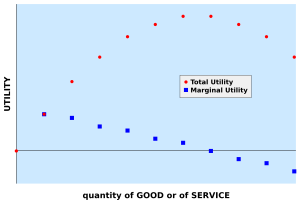Marginal utility facts for kids
Have you ever wondered why that first slice of pizza tastes amazing, but the fifth one isn't quite as exciting? That's a bit like marginal utility. It's an idea in economics that helps us understand how much extra satisfaction or usefulness you get from having one more (or one less) of something.
Economists often talk about the law of diminishing marginal utility. This big phrase just means that the very first item you use or consume usually gives you the most happiness or benefit. After that, each additional item you get gives you a little less extra joy than the one before it. So, the more you have of something, the less exciting each new piece becomes.
Contents
Understanding Marginal Utility
What is Utility?
Before we dive deeper, let's quickly explain utility. In economics, utility simply means the satisfaction, happiness, or benefit you get from something. If you really love ice cream, eating a scoop gives you high utility. If you dislike broccoli, eating it gives you low utility.
How Does it Work?
Marginal utility looks at the change in your satisfaction. Imagine you are very thirsty.
- The first glass of water gives you a lot of satisfaction. It quenches your thirst.
- The second glass of water is still good, but maybe not as amazing as the first. You're less thirsty now.
- The third glass might make you feel full. It gives you even less extra satisfaction.
- If you keep drinking, you might even start to feel uncomfortable. At this point, the marginal utility could become zero or even negative!
This shows how the extra benefit you get from each additional unit tends to go down.
The Law of Diminishing Marginal Utility
Why Does it Diminish?
The idea that marginal utility goes down is called the law of diminishing marginal utility. It's a basic rule in economics. It happens because our needs and wants get satisfied as we consume more of something.
- When you're hungry, the first bite of a sandwich is wonderful.
- The tenth bite is still good, but you're not as hungry.
- The twentieth bite might be too much.
This law helps explain why people don't spend all their money on just one type of thing. They spread their spending around to get the most overall satisfaction.
Real-Life Examples
- Video Games: The first hour of playing a new video game might be super fun. The fifth hour might still be fun, but perhaps you're a bit tired. The tenth hour might feel like a chore if you've played too much.
- Clothes: Buying your first warm coat when it's cold is very useful. Buying a second similar coat is less useful. Buying a tenth similar coat might not add much at all to your comfort.
- Music: Listening to your favorite song for the first time is great. Listening to it a hundred times in a row might make you tired of it!
Marginal Utility and Decision Making
Making Smart Choices
Understanding marginal utility helps people and businesses make better decisions.
- For You: You decide how to spend your money to get the most satisfaction. You buy a variety of things because the extra satisfaction from buying a second pair of shoes might be less than buying a new book.
- For Businesses: Companies think about marginal utility when setting prices. If the extra satisfaction from a product goes down quickly, they might need to lower the price to encourage people to buy more.
Thinking at the "Margin"
Economists often talk about thinking "at the margin." This means looking at the next small step or change.
- Should I buy one more slice of pizza? (What's the marginal utility of that extra slice?)
- Should I study for one more hour? (What's the marginal benefit of that extra hour of study?)
This way of thinking helps us weigh the pros and cons of small changes.
Images for kids
See also
 In Spanish: Utilidad marginal para niños
In Spanish: Utilidad marginal para niños








